|
|
"Im Westen nichts neues", |
|

|
The Sdkfz-231 was the most advanced cross- country wheeled vehicle in the world. Their primary role was to provide infantry support and they well served up till 1942. This armored car carried a 20mm cannon and could defeat light tanks. |
|
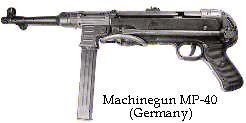 |
MP-40 (Germany)
Caliber: 9x19mm Luger/Para |
|
| The MP-38 and MP-40, often incorrectly referred as "Schmeissers", were developed by german engineer Follmer at the Erma company and adopted by Wehrmacht (German Army) in 1938 and 1940, respectively. The MP-40 is a further modification of the MP-38. Total of some 1.2 millions of MP-38/40 were manufactured prior and during WW2. Initially, MP-38 was intended for use by paratroopers and vehicle crews, but later was widely used by german infantry. Both MP-38 and MP-40 were blowback operated, full auto only submachine guns. MP-38 featured steel machined receiver, while MP-40 featured stamped receiver and stamped magazine veil to make the gun cheaper. The charging handle (located at the left side of the receiver) was used as a safety, locking the bolt in forward or rearward position when placed in cut slots in the receiver. Both MP-38 and MP-40 fired from the open bolt. Both featured special rate of fire reducer, that resulted in very controllable rate of fire of some 400-500 rounds per minute. Both guns featured special detail below the barrel to use the guns from armoured wehicles. Both guns featured underfolding steel buttstock. Both MP-38 and MP-40 featured fixed and hooded front sight and flippable rear sight with settings for 100 and 200 meters. The main drawbacks of the MP 38/40 were the lack of the front handguards that often resulted burned hands during the sustained fire, and the lack of the effective range, when compared to its soviet counterparts (PPSch-41, PPS-43), chambered for more powerful 7.62mm TT round. | ||
| Relative Strength at Sea before WW II | ||||||
|---|---|---|---|---|---|---|
| Germany | Great-Britain | France | ||||
| Aircraft carriers | - | 7 | 1 | |||
| Carriers | - | 2 | 1 | |||
| Battle-ships | 2 | 15 | 7 | |||
| Armoured ships | 3 | - | 7 | |||
| Coasters | - | 3 | - | |||
| Heavy cruisers | 2 | 15 | 7 | |||
| Light cruisers | 6 | 49 | 11 | |||
| Torpedo-boats/destroyers | 38 | 230 | 81 | |||
| Minelayers/cruisers | - | 7 | 4 | |||
| Mine sweepers | 72 | 46 | 16 | |||
| Escort vessels | 10 | 55 | 8 | |||
| Torpedo motor-boats | 25 | 44 | 50 | |||
| Submarine/U-boats | 57 | 62 | 79 | |||
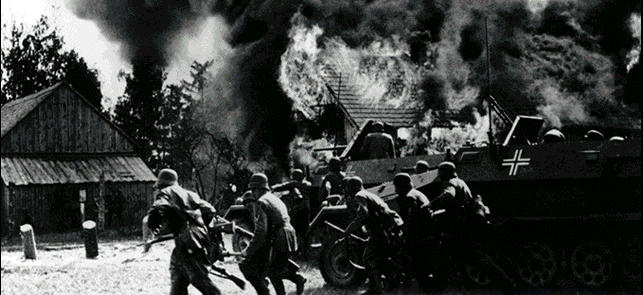
| Relative strenght at the German invasion of Poland | ||||
|---|---|---|---|---|
| Germany | Poland | |||
| Inf. div. | 46 | 38 | ||
| Motor. div. | 4¾ | 11 Cavalry-Brigades | ||
| Light div. | 4 | 2 Motorized Brigades | ||
| Tank div. | 7 | 45 Battalions frontier quard | ||
| Tanks | 3200 | 600 ca. | ||
| Bombers | 1176 | 146 | ||
| Fighters | 771 | 315 50% old models | ||
| Scouting planes | 356 | 325 50% old models | ||
| Other planes | 981 | 56 | ||
| Battle-ships | 2 | -- | ||
| Cruisers | -- | -- | ||
| Destroyers | -- | 4 | ||
| Submarine | 7 | 5 | ||
| Little vessels | -- | 8 | ||
| Torpedo-boats | -- | 2 | ||
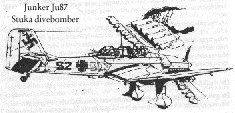
Germany invaded Poland on 1 September 1939. As German armoured columns drove deep into Poland, the Luftwaffe had control of the air. The speed of the invasion gave it the name Blitzkrieg, or lightning war. Between the wars Danzig had been a free city which Hitler was eager to have as part of Germany. The Polish armies were soon encircled or forced to retreat. Although Britain and France declared war on 3 September, they were unable to intervene effectively on Poland's behalf. Germany's Blitzkrieg overran Poland from the west and on 17 September it was invaded by the Soviet Union from the east. On 27 September 1939 Warsaw surrendered and, two days later, Germany and the Soviet Union signed a treaty of friendship which partitioned Poland between them.
Britain declares war:
| Population and industrial capacity | ||||
|---|---|---|---|---|
| Population in 1939 | Steel output in tons | |||
| UK | 47.961.000 | 13.192.000 | ||
| France | 41.600.000 | 6.221.000 | ||
| USSR | 190.000.000 | 18.800.000 | ||
| USA | 132.122.000 | 51.380.000 | ||
| Germany (including Austria) | 76.008.000 | 23.329.000 | ||
| Italy | 44.223.000 | 2.323.000 | ||
| Japan | 71.400.000 | 5.811.000 | ||
| In population and in industrial capacity , the allies, even after losing France, were stronger than the axis powers. | ||||
| Population and industrial capacity by the British Empire Forces | ||||
|---|---|---|---|---|
| Population in 1939 | Steel production in tons (1939) | |||
| Canada | 11.682.000 | 1.407.000 | ||
| South Africa (white) | 2.161.000 | 250.000 | ||
| Australia | 6.807.000 | 1.189.000 | ||
| New Zealand | 1.585.000 | -- | ||
| India | 374.200.000 | 1.035.000 | ||
| The British Commonwealth and Empire possessed further resources for war. Canada and Australia had significant industries, and their populations, like those of New Zealand and white South Africa, were well-educated and physically and mentally capable of providing high-quality recruits. These 4 self-governing 'dominions' followed the British lead and declared war 1939. | ||||
|
|
|
| 1938 | Bombers | 1466 |
|---|---|---|
| Fighters | 920 | |
| 1939 | Bombers | 1553 |
| Fighters | 1090 | |
| 1940 | Bombers | 1558 |
| Fighters | 1290 |
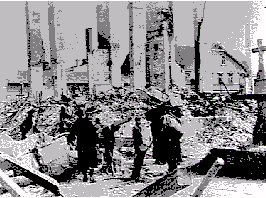
The ruins of Warsaw

| Relative Strength at the begin of Russian-Finnish Winterwar, at full length along Fins-Russian border. | ||
|---|---|---|
| Sowjet- Unie | Finland | |
| ca. 500.000 men | ca. 14.000 men | |
| ca. 30 divisions | 10 divisions | |
| 800 planes | 7 brigades | |
| -- | 150 planes | |
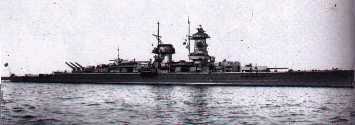
The German battleship Graf Spee
![]()